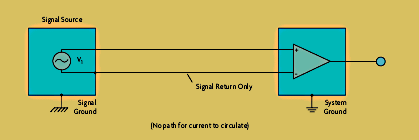
Wire & Cable Options
Generally, two-wire transmission mediums are used to carry an analog signal to or from the field area. A wire carrying an alternating current and voltage may induce noise in a pair of nearby signal leads. A differential voltage/noise will be created since the two wires may be at different distances from the disturbing signal. There are many different wiring options that are available to reduce unwanted noise pickup from entering the line. Four types of wires are fundamental in data acquisition-plain pair, shielded pair, twisted pair, and coaxial cable.
Another important aspect to consider in analog signal transmission is a proper wiring system, which can effectively reduce noise interference. Analog signal transmission typically consists of two-wire signal leads or three-wire signal leads. In systems that require high precision and accuracy, the third signal lead, or shield, is necessary. In the three-wire configuration, the shield is grounded at the signal source to reduce common-mode noise. However, this does not eliminate all of the possibilities of the introduction of noise. It is crucial to prevent the noise pickup by protecting the signal lines. For example, in the case where the noise and signal frequency are the same. In this scenario, the signal cannot be isolated/filtered from the noise at the receiving device.

Figure 3-6: Correct Grounding of Signal Circuit
While plain wire can be used, it is generally not very reliable in screening out noise and is not suggested. A shielded pair is a pair of wires surrounded by a conductor that does not carry current. The shield blocks the interfering current and directs it to the ground. When using shielded pair, it is very important to follow the rules in grounding. Again, the shield must only be grounded at one source, eliminating the possibility of ground-loop currents.
Twisted-pairs help in elimination of noise due to electromagnetic fields by twisting the two signal leads at regular intervals. Any induced disturbance in the wire will have the same magnitude and result in error cancellation.
A coaxial cable is another alternative for protecting data from noise. A coaxial cable consists of a central conducting wire separated from an outer conducting cylinder by an insulator. The central conductor is positive with respect to the outer conductor and carries a current (Figure 3-7). Coaxial cables do not produce external electric and magnetic fields and are not affected by them. This makes them ideally suited, although more expensive, for transmitting signals.
 |
| Figure 3-7: Coaxial Cable Construction |
Although noise and interference cannot be completely removed in the transmission of an analog signal, with good engineering and proper installation, many of the effects of noise and interference can be substantially reduced.
| References and Further Reading | |
| Analog Signal Processing and Instrumentation, Arie F. Arbel, Cambridge University Press, 1980. | |
| Basic Circuit Analysis, David R. Cunningham, and John A. Stuller, Houghton Mifflin Co., 1932. | |
| Circuits: Principles, Analysis, and Simulation, Frank P. Yatsko, and David M. Hata, Saunders College Publishing, 1992. | |
| Data Acquisition and Control, Microcomputer Applications for Scientists and Engineers, Joseph J. Carr, Tab Books Inc., 1988. | |
| Data Communications, A Beginner's Guide to Concepts and Technology, Scott A. Helmers, Prentice-Hall, Inc., 1989. | |
| Digital and Analog Communication Systems, K. Sam Shanmugam, John Wiley & Sons, 1979. | |
| Fundamentals of Transducers, Stan Gibilisco and R. H. Warring, Tab Books Inc., 1985. | |
| Instrument Engineers' Handbook, Third Edition, Bela Liptak, Chilton Book Co., 1995. | |
| Introduction to Signal Transmission, Electrical and Electronic Engineering Series, William R. Bennett, McGraw-Hill, 1970. | |
| Microprocessors in Industrial Measurement and Control, Marvin D. Weiss, Tab Books Inc., 1987. | |
| Modern Digital and Analog Communication Systems, B.P. Lathi, Holt, Rinehart, & Winston, 1983. | |
| Process/Industrial Instruments & Controls Handbook, Fourth Edition, Douglas M. Considine, McGraw-Hill Inc., 1993. | |
| Signals & Systems Made Ridiculously Simple, Zohey Z. Karu, Zi Zi Press, 1995. | |
| Signals, The Telephone and Beyond, John R. Pierce, W. H. Freeman and Co., 1981. | |